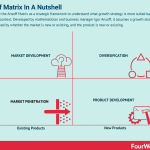The Ansoff Matrix In A Nutshell

You can use the Ansoff Matrix as a strategic framework to understand what growth strategy is more suited based on the market context. Developed by mathematician and business manager Igor Ansoff, it assumes a growth strategy can be derived by whether the market is new or existing, and the product is new or existing.
Ansoff matrix in a nutshell
According to the Ansoff matrix, you can evaluate a growth strategy based on whether you’re trying to grow in an existing market with an existing product (market penetration). Whether you will try to grow in a new market with the same product line (market development). Whether you will try to grow by developing new products in the existing market (product development). Or growing by developing new products for new markets (diversification).
Market penetration
In a market penetration scenario, the company grows by leveraging its existing products, thus trying to increase its market share in its current market.
Therefore, the company will either try to sell more to its customers or to expand its customer base. In this scenario, the company is not trying to expand the boundaries of its market, rather increase its presence on that market.
In short, the company grows by leveraging on its products, within its defined market.
Market penetration case study
Since its inception, Google has been able to grow its market share in search, year over year. By simply leveraging on its core product (the search engine) the company has been able to grow consistently to dominate the search market.
Market development
In this scenario, the company grows by leveraging its products to expand in new markets. Thus, the company will try to make its product available in new markets, geographies.
Market development case study
When Facebook started to roll out, in the early years. The company followed a gradual traction model. Where it opened to more and more universities first, in the US. Then moving to other niches and markets, until it opened to anyone.
Product development
In this scenario, a company grows by developing new products for the existing market, for instance, by developing new products that can benefit the same customer base.
Product development case study
As Instagram was expanding its market share in the social media space, it started to experiment with new features that enabled it to gain more traction within the same market, thus growing quickly.
Diversification
In this scenario, a company grows by going beyond its market boundaries and by developing whole new set of products. Based on the degree in which the new product line and the market is adjacent compared to the existing market (related diversification) and a product line or it goes far beyond it (unrelated diversification).
Diversification case study
When Apple launched the iPhone, back in 2007, it risked cannibalizing its most successful product, the iPod. Yet when the iPhone was out, in a few years would create a whole new category (smartphone) much bigger than that of music player devices. Thus, making Apple develop an entirely new market as a consequence of launching a whole new product.
Other resources:
What Is Business Model InnovationWhat Is a Business ModelWhat Is Business StrategyWhat is BlitzscalingWhat Is Market SegmentationWhat Is a Marketing StrategyWhat is Growth Hacking
The post The Ansoff Matrix In A Nutshell appeared first on FourWeekMBA.



